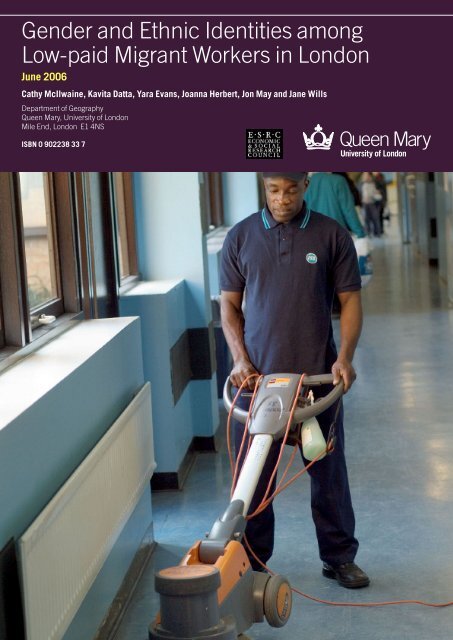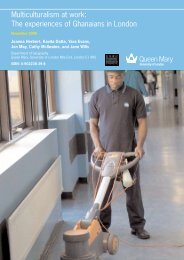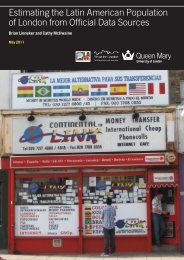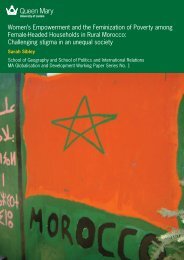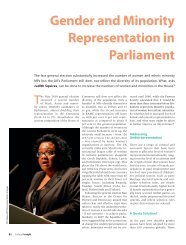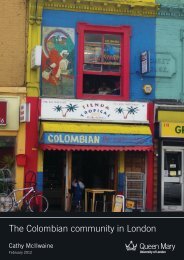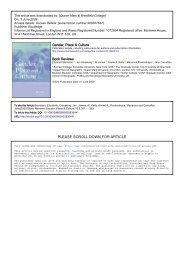Gender and Ethnic Identities among Low-paid Migrant Workers in ...
Gender and Ethnic Identities among Low-paid Migrant Workers in ...
Gender and Ethnic Identities among Low-paid Migrant Workers in ...
- No tags were found...
Create successful ePaper yourself
Turn your PDF publications into a flip-book with our unique Google optimized e-Paper software.
<strong>Gender</strong> <strong>and</strong> <strong>Ethnic</strong> <strong>Identities</strong> <strong>among</strong><br />
<strong>Low</strong>-<strong>paid</strong> <strong>Migrant</strong> <strong>Workers</strong> <strong>in</strong> London<br />
June 2006<br />
Cathy McIlwa<strong>in</strong>e, Kavita Datta, Yara Evans, Joanna Herbert, Jon May <strong>and</strong> Jane Wills<br />
Department of Geography<br />
Queen Mary, University of London<br />
Mile End, London E1 4NS<br />
ISBN 0 902238 33 7
Abstract<br />
Recent commentary on the <strong>in</strong>visibility of women with<strong>in</strong> migration studies has now established that<br />
gender is central to all aspects of mobility. Yet, research which focuses on men, on men <strong>and</strong><br />
women, <strong>and</strong> on men <strong>and</strong>/or women from a range of different ethnic <strong>and</strong> national backgrounds is<br />
much more limited. Draw<strong>in</strong>g on a mixed methods framework, this paper discusses f<strong>in</strong>d<strong>in</strong>gs from a<br />
project exam<strong>in</strong><strong>in</strong>g the experiences of low-<strong>paid</strong> migrant workers <strong>in</strong> London. It illustrates, first, the<br />
fluid <strong>and</strong> cont<strong>in</strong>gent nature of migrant identities from a gender, <strong>and</strong> to a lesser extent, ethnic<br />
perspective. Second, it highlights the ways <strong>in</strong> which migrants often attempt to rationalise their<br />
labour market experiences <strong>in</strong> order to validate their position <strong>in</strong> low-<strong>paid</strong> <strong>and</strong> low status jobs. For<br />
men who f<strong>in</strong>d themselves work<strong>in</strong>g <strong>in</strong> female-dom<strong>in</strong>ated sectors, efforts to validate their position <strong>in</strong><br />
such jobs often move around attempts to highlight the hardships such work entails <strong>in</strong> an attempt to<br />
reclaim the ‘mascul<strong>in</strong>e’ attributes of what might otherwise be seen as ‘women’s work’. Both men<br />
<strong>and</strong> women also often attempt to promote the higher status of their own ethnic group through<br />
claims to be especially hard work<strong>in</strong>g <strong>and</strong> thus superior to other migrant groups.<br />
2
Introduction<br />
‘Here, if you arrive on ‘high heels’ [full of pride], with<strong>in</strong> the first month you will walk<br />
barefoot, the shoes <strong>and</strong> the heels will be gone. I th<strong>in</strong>k that when I first arrived here I was a<br />
bit on ‘high heels’. But I soon realised that you could not be like that here. My work here<br />
has noth<strong>in</strong>g to do with the one I do <strong>in</strong> Brazil. I have never been a decorator. I had never<br />
done a clean<strong>in</strong>g [job]. But here, you have to give it value, because that is what you have’<br />
(Joao, a construction worker from Brazil)<br />
Joao is from Goiania <strong>in</strong> Brazil <strong>and</strong> arrived <strong>in</strong> London over a year ago. Unemployed dur<strong>in</strong>g his first<br />
month <strong>in</strong> London, he has s<strong>in</strong>ce had three jobs: as a baker <strong>in</strong> a Portuguese bakery, as an office<br />
cleaner, <strong>and</strong> as a construction worker. All three of these jobs have been accessed through ethnic<br />
(friendship) networks. At the time of the <strong>in</strong>terview, he was employed <strong>in</strong> both office clean<strong>in</strong>g <strong>and</strong><br />
construction work. Given that he has a university degree <strong>and</strong> worked as a teacher <strong>in</strong> Brazil, he has<br />
experienced significant deskill<strong>in</strong>g <strong>in</strong> London. He speaks very little English, <strong>and</strong> partly due to this,<br />
most of his friends are Brazilians.<br />
This brief account of Joao’s labour market experiences <strong>in</strong> London illustrates many of the issues we<br />
want to explore <strong>in</strong> this paper. Not least, Joao’s story captures someth<strong>in</strong>g of the fluidity of identity<br />
that migrants experience on mov<strong>in</strong>g to the UK labour market. Here we want to focus especially on<br />
the fluidity of gender identities, <strong>and</strong> the way <strong>in</strong> which questions of gender are cross-cut by<br />
nationality <strong>and</strong> ethnicity. While migrants have gendered expectations of work, occupations <strong>in</strong> the<br />
UK are also gendered. At the same time, as migration works to erode traditional gender divides <strong>in</strong><br />
the UK labour market, male migrants often f<strong>in</strong>d themselves do<strong>in</strong>g ‘women’s’ work. Such moves<br />
impact on the identities of male migrants as they attempt to make sense of, <strong>and</strong> cope with, lowstatus<br />
jobs.<br />
Scholars of migration have only recently noted gender relations as be<strong>in</strong>g ‘a constitutive feature of<br />
the social, economic, <strong>and</strong> cultural constellations that structure migration’ <strong>and</strong> recognised the ways<br />
<strong>in</strong> which migration processes reshape gender identities (Hondagneu-Sotelo 1999: 566). With such<br />
recognition, <strong>and</strong> especially <strong>in</strong> relation to the burgeon<strong>in</strong>g work on transnational migration, gender<br />
has <strong>in</strong>creas<strong>in</strong>gly been identified as relational <strong>and</strong> closely cross-cut by race, ethnicity, nationality <strong>and</strong><br />
sexuality (Mahler <strong>and</strong> Pessar 2006). Yet, while calls have been made for studies of the gender<strong>in</strong>g<br />
of migration, <strong>and</strong> especially transnational migration (Boyle 2002), there rema<strong>in</strong>s little work which<br />
3
focuses on the relations between men <strong>and</strong> women <strong>in</strong> the migration process, <strong>and</strong> even less which<br />
considers such relations from the perspective of a range of different ethnic groups. Despite a<br />
grow<strong>in</strong>g <strong>and</strong> significant body of work on domestic workers <strong>and</strong> sex workers throughout the world<br />
(Anderson, 2000; Ehrenreich <strong>and</strong> Hochschild [eds] 2002; Hondagneu-Sotelo 2001; Momsen [ed]<br />
1999), nor is there much research on the ways <strong>in</strong> which male <strong>and</strong> female migrants negotiate their<br />
gender <strong>and</strong> ethnic identities across different fields of employment (Raghuram <strong>and</strong> Kofman 2004).<br />
Such a lack partly reflects the concentration of research on Lat<strong>in</strong> American migration to North<br />
America <strong>and</strong> on Filip<strong>in</strong>o migration throughout the world, with much less work on other flows,<br />
especially to Europe (ibid.; Pessar <strong>and</strong> Mahler 2003). So too, the focus on migrant identities, rather<br />
than mobility behaviour, is relatively new (Silvey 2004), whilst there rema<strong>in</strong>s considerable scope<br />
for research on the constructions of these identities at a range of scales.<br />
Tak<strong>in</strong>g gender as its primary focus, this paper explores the fluid <strong>and</strong> cont<strong>in</strong>gent identities that<br />
emerge as migrants enter London’s low <strong>paid</strong> labour market, <strong>and</strong> the <strong>in</strong>ter-relations of gender <strong>and</strong><br />
ethnic identities. It highlights the ways <strong>in</strong> which migrants seek to validate the types of jobs they do<br />
<strong>in</strong> order to rationalise their position <strong>in</strong> low <strong>paid</strong>, low status sectors of the London labour market.<br />
Such valorisation appears to be especially pert<strong>in</strong>ent to male migrants, many of whom end-up <strong>in</strong><br />
female dom<strong>in</strong>ated sectors. The paper draws on work <strong>in</strong> progress <strong>and</strong> is based on 341 questionnaires<br />
with low-<strong>paid</strong> workers of which 307 were migrants, <strong>and</strong> 56 <strong>in</strong>-depth <strong>in</strong>terviews conducted with<br />
migrants employed <strong>in</strong> London’s clean<strong>in</strong>g, care, construction <strong>and</strong> hospitality sectors.<br />
We beg<strong>in</strong> by engag<strong>in</strong>g with conceptual debates perta<strong>in</strong><strong>in</strong>g to gender, ethnicity, migration <strong>and</strong> labour<br />
markets before briefly outl<strong>in</strong><strong>in</strong>g the methodological framework adopted <strong>in</strong> this study. The ma<strong>in</strong><br />
body of the paper is devoted to empirical f<strong>in</strong>d<strong>in</strong>gs. These are organised <strong>in</strong> three sections, build<strong>in</strong>g a<br />
composite picture of migrant workers identities <strong>in</strong> London. The first focuses on migrant identities,<br />
the second on gendered migrant identities, <strong>and</strong> the f<strong>in</strong>al part on ethnic migrant identities.<br />
<strong>Gender</strong> <strong>and</strong> ethnic identities, migration, <strong>and</strong> work practices<br />
While early research on gender <strong>and</strong> migration focused on remedy<strong>in</strong>g the exclusion of women from<br />
migration studies by mak<strong>in</strong>g them visible <strong>in</strong> migration flows, more recent work has adopted a more<br />
holistic approach. This argues that gender is an <strong>in</strong>tegral component permeat<strong>in</strong>g all migration<br />
processes at various scales whether the <strong>in</strong>dividual, family, state or labour market (Donato et al.,<br />
2006; Hondagneu-Sotelo <strong>and</strong> Cranford 1999; Pessar, 2005). Such research has seen a recurr<strong>in</strong>g<br />
debate concern<strong>in</strong>g the extent to which migration should be viewed as empower<strong>in</strong>g or exploitative<br />
4
for women (Hondagneu-Sotelo 1999). While early research highlighted the emancipatory potential<br />
of migration for women, more recent work has been more tempered <strong>in</strong> such claims. Such work has<br />
highlighted a range of exploitative dimensions, <strong>and</strong> noted the connections between changes <strong>in</strong><br />
gender ideologies <strong>and</strong> differ<strong>in</strong>g employment histories, family <strong>and</strong> state structures <strong>and</strong> practices<br />
(Mahler 1999; Menjívar 1999), class positions <strong>and</strong> (especially) ethnicity (Willis <strong>and</strong> Yeoh 2000).<br />
Yet, while recent years have seen <strong>in</strong>creas<strong>in</strong>g recognition of the role of women <strong>in</strong> the migration<br />
process, the same period has seen a grow<strong>in</strong>g tendency to (re)marg<strong>in</strong>alize male migrants. It is also<br />
rare to consider male <strong>and</strong> female migrants together, or to explore the relational aspects of<br />
mascul<strong>in</strong>ity <strong>and</strong> fem<strong>in</strong><strong>in</strong>ity (see Gutmann 1997). Reflect<strong>in</strong>g wider patterns with<strong>in</strong> gender research<br />
that often highlights erroneous <strong>and</strong> homogenous representations of men as the ‘pathological other’<br />
or ‘custodians of patriarchy’ (Datta 2004; McIlwa<strong>in</strong>e <strong>and</strong> Datta 2004), migration research also<br />
tends to highlight “deficit” mascul<strong>in</strong>ities revolv<strong>in</strong>g around issues such as spousal <strong>and</strong> family<br />
desertion (although see Pribilsky 2004). Similarly, the role of migration as a rite of passage for<br />
adolescent men to become adults has focused on the performance of “hyper-mascul<strong>in</strong>ities” often<br />
lead<strong>in</strong>g to gender violence, <strong>and</strong> the fact that men left beh<strong>in</strong>d are viewed as failures who do not take<br />
over reproductive roles (Boehm 2004), a view that is now be<strong>in</strong>g challenged (Manalansan IV 2006).<br />
The need, therefore, is for a more systematic analysis of how migration creates new gendered<br />
conventions <strong>and</strong> challenges for both women <strong>and</strong> men. Central to this is an appreciation that gender<br />
is a relational <strong>and</strong> fluid construction, permeated by a range of different hierarchies of power.<br />
Clearly, gender relations are crosscut by other cleavages such as race, ethnicity, nationality, class,<br />
age <strong>and</strong> sexuality. At the same time, ethnicity <strong>and</strong> nationality too are constitutive of, <strong>and</strong> constituted<br />
by, migration. This is partly evidenced <strong>in</strong> the flows <strong>and</strong> patterns of transnational migration. With<strong>in</strong><br />
specific ethnic communities, men <strong>and</strong> women may also perform different roles – with women<br />
sometimes particularly valued as bearers of tradition <strong>and</strong> culture: as ‘ethnomarkers’ charged with<br />
the responsibility of pass<strong>in</strong>g on values <strong>and</strong> customs (Yeoh <strong>and</strong> Willis 2004). By the same token,<br />
ethnic traditions may reproduce patriarchal conventions which are harmful for women.<br />
These complex processes are played out, <strong>and</strong> affected by, “different scales <strong>and</strong> transnational<br />
spaces” (Pessar <strong>and</strong> Mahler 2003: 822) such that gender identities, ideologies <strong>and</strong> practices are<br />
formulated, challenged, <strong>and</strong> negotiated <strong>in</strong> manifold ways as people move across borders <strong>and</strong><br />
ma<strong>in</strong>ta<strong>in</strong> ties with their home country <strong>in</strong> what have become transnational social spaces (Fouron <strong>and</strong><br />
Glick-Schiller 2001; Mahler 1999; Pessar 2005). Thus, accord<strong>in</strong>g to Vertovec (2001: 578), ‘the<br />
5
multi-local life-world presents a wider, even more complex set of conditions that affect the<br />
construction, negotiation <strong>and</strong> reproduction of social identities’. Transnational identities challenge<br />
essentialist notions of identity construction ma<strong>in</strong>ly because they are formed across borders <strong>and</strong> are<br />
subject to a huge diversity of <strong>in</strong>fluences (Huang et al. 2000; Yeoh et al. 2003). While not always<br />
explicitly acknowledged, this has important ramifications for men <strong>and</strong> women <strong>in</strong> different ways. In<br />
particular, this depends on pre-migration ideologies, the nature of hegemonic (<strong>and</strong> counterhegemonic)<br />
gender regimes, the extent to which gender beliefs are reproduced or <strong>in</strong>tensified <strong>and</strong> the<br />
type of migration undertaken (Pessar 2005; also Hondagneu-Sotelo 1992; Parrenas 2005; Pessar<br />
<strong>and</strong> Mahler 2006).<br />
Also important here are the ways <strong>in</strong> which migrants are <strong>in</strong>corporated <strong>in</strong> to labour markers (Boehm<br />
2004; Pessar <strong>and</strong> Mahler 2006). It should not be forgotten that the actual lives of migrants revolve<br />
around survival for themselves <strong>and</strong> their families both <strong>in</strong> situ <strong>and</strong> <strong>in</strong> home countries. Thus,<br />
ideological changes <strong>in</strong> gender <strong>and</strong> ethnic identities must be exam<strong>in</strong>ed not only <strong>in</strong> relation to<br />
peoples’ migration histories, but also <strong>in</strong> terms of how they are <strong>in</strong>serted <strong>in</strong> the labour market of<br />
‘recipient’ countries <strong>and</strong> their relations with other ethnic groups <strong>in</strong> these countries.<br />
It is recognised that the labour market experiences of migrant women are <strong>in</strong>variably shaped out of<br />
ideologies of domesticity <strong>and</strong> fem<strong>in</strong><strong>in</strong>ity thus re<strong>in</strong>forc<strong>in</strong>g gendered occupational stereotyp<strong>in</strong>g (Brah<br />
1996). Women migrants reta<strong>in</strong> primary responsibility for housework <strong>and</strong> childcare, despite their<br />
participation <strong>in</strong> <strong>paid</strong> work (as do non-migrant women) (Alicea 1997; George 1998). Women<br />
everywhere suffer from stereotyp<strong>in</strong>g <strong>and</strong> multiple dem<strong>and</strong>s on their time, <strong>and</strong> low-<strong>in</strong>come women<br />
migrants are especially affected because of their unequal <strong>in</strong>corporation <strong>in</strong>to the labour markets of<br />
both develop<strong>in</strong>g Southern <strong>and</strong> developed Northern economies (Hale <strong>and</strong> Wills 2005). However, the<br />
position of migrant men is often not much better, certa<strong>in</strong>ly <strong>in</strong> terms of their concentration <strong>in</strong> the<br />
low-<strong>paid</strong> service sectors of the economy. Thus, while the ‘bottom end’ service jobs of the cities of<br />
the Global North have long been associated with women’s work, <strong>in</strong>creas<strong>in</strong>g numbers of male <strong>and</strong><br />
female black <strong>and</strong> m<strong>in</strong>ority ethnic <strong>and</strong> migrant workers are mov<strong>in</strong>g <strong>in</strong>to this semi-skilled, low-wage,<br />
rout<strong>in</strong>ised <strong>and</strong> unprotected employment (Holgate, 2004; May et al., 2006; McDowell, 2004).<br />
In turn, different ethnic groups f<strong>in</strong>d themselves concentrated <strong>in</strong> different sectors of the labour<br />
market – someth<strong>in</strong>g that can be attributed <strong>in</strong> part to ethnic stereotyp<strong>in</strong>g, partly to the role of ethnic<br />
networks <strong>in</strong> access<strong>in</strong>g work, <strong>and</strong> partly to <strong>in</strong>stitutional discrim<strong>in</strong>ation (Rydgren 2004). Yeoh <strong>and</strong><br />
Willis (2004) illustrate the social <strong>and</strong> economic challenges that ethnic migrant men may face as<br />
6
“men of colour” are forced to compete for jobs <strong>in</strong> female-dom<strong>in</strong>ated low-<strong>paid</strong> sectors. Conversely,<br />
while participation <strong>in</strong> ethnic enclave economies may provide benefits for migrants <strong>in</strong> general, this<br />
may be much less so for women compared to men (Gilbertson 1995). This paper considers the<br />
ramifications of these complex processes <strong>in</strong> the context of low-<strong>paid</strong> migrant workers <strong>in</strong> London.<br />
Methodological issues<br />
Recently, there have been calls for adopt<strong>in</strong>g more holistic mixed methods approaches to the study<br />
of gender <strong>and</strong> migration (Donato et al. 2006). This has ma<strong>in</strong>ly been to counter claims that it is<br />
difficult to make generalisations from qualitative work on gender, while at the same time<br />
recognis<strong>in</strong>g that such studies can successfully uncover the dynamics <strong>and</strong> processes of gendered<br />
migration <strong>in</strong> ways that quantitative approaches cannot (Pessar <strong>and</strong> Mahler 2006). Thus, a comb<strong>in</strong>ed<br />
approach can be complimentary <strong>and</strong> productive for explor<strong>in</strong>g the lives of female <strong>and</strong> male migrants<br />
<strong>in</strong> holistic ways.<br />
In reflect<strong>in</strong>g such a perspective, this paper draws on a questionnaire survey <strong>and</strong> <strong>in</strong>-depth <strong>in</strong>terviews<br />
conducted with workers <strong>in</strong> low <strong>paid</strong> sectors of the London economy. Our broad aim was to explore<br />
who was work<strong>in</strong>g, <strong>and</strong> under what conditions, at the bottom end of the London labour market.<br />
Thus, the questionnaire survey (for which we worked with London’s Citizens <strong>and</strong> a team of eleven<br />
researchers) 1 sought to <strong>in</strong>vestigate the pay, work<strong>in</strong>g conditions, household circumstances <strong>and</strong><br />
migration histories of workers <strong>in</strong> four key sectors of London’s economy (see Evans et al. 2005;<br />
May et al 2006). These were contracted clean<strong>in</strong>g staff work<strong>in</strong>g on London Underground; general<br />
office clean<strong>in</strong>g; hospitality workers, particularly focused on luxury hotels; <strong>and</strong> home care<br />
employment. In addition, a number of workers <strong>in</strong> the food process<strong>in</strong>g <strong>in</strong>dustry were <strong>in</strong>cluded <strong>in</strong> the<br />
research. These were accessed through exist<strong>in</strong>g contacts with trade union representatives, through<br />
snowball<strong>in</strong>g <strong>and</strong> also via a r<strong>and</strong>om cold-call<strong>in</strong>g process. In total, 341 low <strong>paid</strong> workers were<br />
<strong>in</strong>terviewed of which 307 were migrants. The majority of <strong>in</strong>terviews were conducted face-to-face<br />
<strong>in</strong> a range of languages <strong>in</strong>clud<strong>in</strong>g Polish, Portuguese, Spanish <strong>and</strong> French. The migrants came from<br />
56 different countries with significant numbers from sub-Saharan Africa (55%) (especially Ghana<br />
<strong>and</strong> Nigeria), Lat<strong>in</strong> America <strong>and</strong> the Caribbean (15%) (especially Brazil, Colombia <strong>and</strong> Jamaica),<br />
Eastern Europe (10%) (especially Pol<strong>and</strong>), <strong>and</strong> Asia <strong>and</strong> South East Asia (7%). They <strong>in</strong>cluded a<br />
range of documented <strong>and</strong> undocumented migrants.<br />
In-depth <strong>in</strong>terviews followed on from the questionnaire survey <strong>and</strong> have been conducted by the<br />
authors. In the ma<strong>in</strong>, access to respondents has been facilitated by follow<strong>in</strong>g up on people who<br />
7
participated <strong>in</strong> the questionnaire survey <strong>and</strong> expressed an <strong>in</strong>terest <strong>in</strong> be<strong>in</strong>g <strong>in</strong>terviewed, while other<br />
workers have been accessed via snowball<strong>in</strong>g. These <strong>in</strong>terviews have gathered <strong>in</strong>formation on<br />
migration histories, settlement experiences <strong>in</strong> the UK, attitudes <strong>and</strong> feel<strong>in</strong>gs towards employment,<br />
household circumstances <strong>and</strong> cop<strong>in</strong>g strategies, together with issues surround<strong>in</strong>g community<br />
identity <strong>and</strong> l<strong>in</strong>kages with home countries. This is work <strong>in</strong> progress <strong>and</strong> here we focus specifically<br />
on 56 <strong>in</strong>terviews with male <strong>and</strong> female migrants <strong>in</strong> all of the above sectors as well as construction. 2<br />
<strong>Gender</strong> <strong>and</strong> ethnic segmentation <strong>in</strong> London’s low-<strong>paid</strong> labour market<br />
It is important to beg<strong>in</strong> this discussion of our f<strong>in</strong>d<strong>in</strong>gs by contextualis<strong>in</strong>g the labour market <strong>in</strong><br />
which low-<strong>paid</strong> migrant workers identities are constructed <strong>and</strong> reconstructed. Our questionnaire<br />
data clearly illustrates two broad patterns operat<strong>in</strong>g <strong>in</strong> London’s labour market: namely, what we<br />
have termed a “migrant division of labour” (see May et al. 2006), which is also cross-cut by a<br />
gendered <strong>and</strong> ethnic division of labour. A migrant division of labour is clearly evident <strong>in</strong> cities such<br />
as London where a high proportion of low-<strong>paid</strong> elementary occupations are occupied by migrants<br />
(ibid. 2006; see also Spence 2005). This dem<strong>and</strong> for ‘low end’ workers has been created by the<br />
large amounts of office space to be cleaned <strong>and</strong> ma<strong>in</strong>ta<strong>in</strong>ed, together with massive build<strong>in</strong>g<br />
programmes <strong>in</strong> the construction sector, <strong>and</strong> a health <strong>and</strong> care sector that has become heavily<br />
dependent on sub-contracted labour. With poor wages <strong>and</strong> conditions on offer, it is often only<br />
migrants who are will<strong>in</strong>g to work <strong>in</strong> such occupations, <strong>and</strong> sometimes only the undocumented.<br />
Cross cutt<strong>in</strong>g such a divide, however, are also clear l<strong>in</strong>es of gender <strong>and</strong> ethnic segmentation <strong>and</strong><br />
segregation. For example, whilst almost half (47%) of the people we surveyed were women, men<br />
<strong>and</strong> women worked <strong>in</strong> quite different jobs. Generally, women worked <strong>in</strong> ‘semi-private’ spaces such<br />
as hotels as chambermaids (58.5% of hotel workers), <strong>and</strong> <strong>in</strong> the case of care work, the houses of<br />
clients (81.5% of workers), whilst men worked <strong>in</strong> ‘semi-public’ spaces such as office clean<strong>in</strong>g<br />
(70% of workers be<strong>in</strong>g men) or on the Underground (64% of all workers). Sectors such as<br />
construction comprised, perhaps unsurpris<strong>in</strong>gly, an all male workforce. 3 Particular migrant groups<br />
also tended to be concentrated by ethnicity <strong>and</strong> nationality. Whilst it is estimated that the majority<br />
of London’s migrants (70%) come from the Global South (Spence 2005), with<strong>in</strong> our survey Black<br />
Africans made up over three-quarters of the surveyed workforce <strong>in</strong> clean<strong>in</strong>g on the London<br />
Underground. They also represented the largest share of all workers <strong>in</strong> care work (44%) <strong>and</strong> <strong>in</strong><br />
clean<strong>in</strong>g <strong>and</strong> other services (37%). Non British Whites, <strong>in</strong> turn, comprised two-fifths of surveyed<br />
workers <strong>in</strong> hotel <strong>and</strong> hospitality, <strong>and</strong> one-fifth of workers <strong>in</strong> clean<strong>in</strong>g <strong>and</strong> other services. More than<br />
half of those employed as contract cleaners on London Underground were from Ghana or Nigeria<br />
8
(58%), with a quarter of those employed <strong>in</strong> office clean<strong>in</strong>g from Lat<strong>in</strong> America (26%), <strong>and</strong> just<br />
over a quarter of those employed <strong>in</strong> hotel <strong>and</strong> hospitality work from Eastern Europe (27%) (see<br />
Evans et al. 2005).<br />
Also important were the ways <strong>in</strong> which gender <strong>and</strong> ethnicity <strong>in</strong>tersected. Aga<strong>in</strong> draw<strong>in</strong>g on our<br />
survey, Black African men were concentrated <strong>in</strong> the ‘fem<strong>in</strong>ised’ clean<strong>in</strong>g <strong>and</strong> care sectors,<br />
compris<strong>in</strong>g 80% of all male workers clean<strong>in</strong>g on the London Underground, over half of all male<br />
care workers (57%) <strong>and</strong> just under half of all general cleaners (47%). There were concentrations of<br />
Non British White men <strong>in</strong> the hospitality sector (33%) <strong>and</strong> general clean<strong>in</strong>g (23%). Black African<br />
women were also, like their male ethnic counterparts, concentrated <strong>in</strong> clean<strong>in</strong>g on the Underground<br />
(76% of all female workers <strong>in</strong> this sector), <strong>and</strong> <strong>in</strong> the care sector (57% of all female workers <strong>in</strong> the<br />
sector), with nearly half of all women workers <strong>in</strong> hospitality be<strong>in</strong>g of Non British White orig<strong>in</strong><br />
(49%).<br />
What this data illustrates very broadly is the migrant, gender <strong>and</strong> ethnic segmentation of London’s<br />
labour market. Yet, while these broad patterns can be traced, far less is known about the<br />
experiences of low-<strong>paid</strong> migrant workers <strong>in</strong> London <strong>and</strong> <strong>in</strong> particular the gender<strong>in</strong>g of those<br />
experiences (for exceptions see Anderson 2001; Cox <strong>and</strong> Watt 2002). Thus we turn now to<br />
exam<strong>in</strong>e the nature of low-<strong>paid</strong> migrant identities across a range of labour market sectors focus<strong>in</strong>g<br />
specifically on how people make sense of their work.<br />
<strong>Low</strong>-<strong>paid</strong> migrant workers identities<br />
From a conceptual perspective, the ways <strong>in</strong> which migrants perceive themselves <strong>and</strong> are<br />
characterised by others (Vertovec 2001: 573), or <strong>in</strong> other words, their identities <strong>in</strong> any host country,<br />
are now acknowledged as multiple, fluid <strong>and</strong> dynamic (F<strong>in</strong>dlay et al. 2004). While identities are<br />
constructed through people’s <strong>in</strong>teraction <strong>in</strong> a range of different <strong>and</strong> overlapp<strong>in</strong>g doma<strong>in</strong>s, we want<br />
to focus here on migrant workers’ identities, <strong>and</strong> especially those associated with work. Despite the<br />
fact that migrants, both documented <strong>and</strong> undocumented, cont<strong>in</strong>ue to work <strong>in</strong> the ‘dirty, difficult <strong>and</strong><br />
dangerous’ jobs (IPPR 2006: 11) that no-one else wants, popular representations particularly <strong>in</strong> the<br />
media cont<strong>in</strong>ue to perpetuate the view that they are lazy, tak<strong>in</strong>g jobs from the native-born, <strong>and</strong><br />
unlawfully access<strong>in</strong>g benefits. As Hugo (2005: 22) notes: ‘There is a great deal of myth creation <strong>in</strong><br />
relation to migrants <strong>and</strong> migrant workers. They are frequently made scapegoats for all k<strong>in</strong>ds of<br />
problems be<strong>in</strong>g faced by host societies’.<br />
9
The migrants <strong>in</strong> our study were fully aware of these types of images. Most compla<strong>in</strong>ed of the<br />
difficulties of secur<strong>in</strong>g decent employment, often because of their migrant status or ethnic group<br />
(see below). In relation to claim<strong>in</strong>g benefits, most migrants were clear that they never had any<br />
<strong>in</strong>tention of accept<strong>in</strong>g assistance from the state, not least because there was rarely a function<strong>in</strong>g<br />
welfare system <strong>in</strong> most of the countries they had migrated from. Christ<strong>in</strong>a, a care worker from<br />
Nigeria, said that, “we don’t [claim], everybody work because whoever came from my country we<br />
believe <strong>in</strong> work<strong>in</strong>g, nobody depended, you don’t have to depend on anybody.”<br />
This was also born out <strong>in</strong> our survey data <strong>in</strong> that 94% of people <strong>paid</strong> tax <strong>and</strong> National Insurance,<br />
whilst fewer than 1 <strong>in</strong> 5 (16%) claimed any k<strong>in</strong>d of state benefits (Work<strong>in</strong>g Tax Credits, Child<br />
Benefit etc.). Also significant is that contribut<strong>in</strong>g to the tax base of the country was not conf<strong>in</strong>ed to<br />
documented migrants <strong>in</strong> that most of those who were undocumented also <strong>paid</strong> tax <strong>and</strong> National<br />
Insurance (see also McIlwa<strong>in</strong>e 2005 on Colombians). Jose, a Brazilian construction worker po<strong>in</strong>ted<br />
out:<br />
‘They [the government] should put <strong>in</strong> their head that a person who travels 12,000 km to<br />
come to a place to work <strong>and</strong> earn money, we don’t come here just to take their money<br />
away, because I pay tax. I pay at least £400 per month. That is the m<strong>in</strong>imum I pay ....<br />
Where does this money go to If I buy one glass, I am already pay<strong>in</strong>g taxes, because the<br />
market pays taxes but so do I … Not only Brazilians, it is thous<strong>and</strong>s of illegal people. Can<br />
you imag<strong>in</strong>e how many trillions they leave to the government What does the government<br />
do with this money’<br />
In light of such discourses imposed on migrant workers as well as their own material experiences, it<br />
is perhaps not surpris<strong>in</strong>g that many responded by consistently highlight<strong>in</strong>g the difficulties of their<br />
work <strong>and</strong> how hard they had to work. Indeed, it is <strong>in</strong>disputable that their work<strong>in</strong>g conditions are<br />
poor. Aga<strong>in</strong>, on the basis of the survey data, it emerged that workers received extremely low rates<br />
of pay with 90% of workers earn<strong>in</strong>g less than the Greater London Authority's Liv<strong>in</strong>g Wage for<br />
London (£6.70 an hour), with average earn<strong>in</strong>gs only £5.45 an hour 4 , <strong>and</strong> few receiv<strong>in</strong>g any benefits.<br />
In turn, more than half of the respondents worked unsociable hours (the early, late or nightshift),<br />
with two fifths work<strong>in</strong>g overtime <strong>in</strong> order to <strong>in</strong>crease their earn<strong>in</strong>gs, usually at the same rate (see<br />
Evans et al. 2005 for more details).<br />
10
The conditions of work were also poor with both male <strong>and</strong> female migrants compla<strong>in</strong><strong>in</strong>g about the<br />
unhealthy, <strong>and</strong> at times unsafe, work<strong>in</strong>g environment. Kwame from Ghana who was a cleaner on<br />
the Underground reported that his work was:<br />
‘Very hard, tra<strong>in</strong> work is very hard, pick<strong>in</strong>g tra<strong>in</strong>s, because we’ve got a lot of rubbish <strong>in</strong>side<br />
that I open before com<strong>in</strong>g here <strong>and</strong> afterwards we have to take all that rubbish outside to<br />
the b<strong>in</strong> room. Because you know carbon dioxide, sometimes if you use like cotton, white<br />
cotton, clean<strong>in</strong>g your nose you see there is a black carbon deposit because of the electricity<br />
down here <strong>and</strong> the tra<strong>in</strong> will be us<strong>in</strong>g it… put your h<strong>and</strong> on the wall or you use some glove<br />
to clean it, before you know it it’s black. It’s no good for our health’.<br />
Women also compla<strong>in</strong>ed about how difficult their jobs were. Zofia, a chambermaid from Pol<strong>and</strong><br />
who worked <strong>in</strong> a large hotel compla<strong>in</strong>ed about the number of rooms she had to clean, often as many<br />
as 20 per shift.<br />
‘I was too exhausted. In the first month I had bleed<strong>in</strong>g from my nose I was so tired <strong>and</strong><br />
weakened. Every day that I had to go there I wanted to cry. They gave this list of rooms<br />
that one has to clean. Every morn<strong>in</strong>g we have to go to the office <strong>and</strong> to st<strong>and</strong> <strong>in</strong> the queue<br />
to get this list of rooms <strong>and</strong> the uniform. It does make one feel like a ‘C<strong>in</strong>derella’”.<br />
Indeed, migrants <strong>in</strong> all sectors compla<strong>in</strong>ed about their workloads, repeatedly argu<strong>in</strong>g that they were<br />
do<strong>in</strong>g the work of at least two people. This was especially marked <strong>in</strong> contract clean<strong>in</strong>g <strong>and</strong><br />
hospitality work. <strong>Workers</strong> clean<strong>in</strong>g offices were often exasperated by the amount of work they<br />
were expected to do, say<strong>in</strong>g that they had to do everyth<strong>in</strong>g <strong>in</strong> a rush <strong>in</strong> order to meet the targets <strong>and</strong><br />
often without sufficient clean<strong>in</strong>g material. Angela, a Portuguese cleaner who worked <strong>in</strong> the offices<br />
of a bank noted how she had to clean 20 offices <strong>in</strong> her shift, only manag<strong>in</strong>g to empty the rubbish<br />
b<strong>in</strong>s <strong>in</strong> 3 hours, after which she only had 3 hours to clean the desks, vacuum the floor <strong>and</strong> clean the<br />
bathrooms <strong>and</strong> kitchens. She compla<strong>in</strong>ed that her managers ‘th<strong>in</strong>k that cleaners are mach<strong>in</strong>es’.<br />
These workloads often led to physical illness. Just as Zofia had nose bleeds because she was so<br />
tired, Pedro, a Brazilian office cleaner had constant pa<strong>in</strong> <strong>and</strong> swell<strong>in</strong>g <strong>in</strong> both arms because of his<br />
workload: ‘The work load is too heavy, too heavy. Many people don’t show up for work because it<br />
is too much work. I have a problem <strong>in</strong> my arm, both arms, because of the workload. I've been <strong>in</strong> the<br />
doctor twice <strong>and</strong> he prescribed a medic<strong>in</strong>e but the pa<strong>in</strong> rema<strong>in</strong>s’.<br />
11
Others felt that the ma<strong>in</strong> hardships they endured were not just about the hours <strong>and</strong> workload, but<br />
from their experiences with both their supervisors <strong>and</strong> managers <strong>and</strong> with their clients. In<br />
hospitality, chambermaids frequently compla<strong>in</strong>ed about their treatment at the h<strong>and</strong>s of<br />
housekeepers. While this usually <strong>in</strong>volved verbal abuse <strong>and</strong> especially humiliation <strong>in</strong> front of other<br />
colleagues, <strong>in</strong> several extreme cases, physical abuse was noted. Sylwia, a Polish chambermaid <strong>in</strong> a<br />
hotel reported how one housekeeper slapped another Polish woman <strong>in</strong> the face because she didn’t<br />
underst<strong>and</strong> the <strong>in</strong>structions she was given <strong>in</strong> English. This same housekeeper often bullied other<br />
workers, push<strong>in</strong>g them, scream<strong>in</strong>g at them <strong>and</strong> call<strong>in</strong>g them names. In the care sector, workers had<br />
most problems with their clients as Gladys, a care worker from Ghana noted: ‘some clients are<br />
very, very greedy, one hour they want you to do a whole lot of th<strong>in</strong>gs, <strong>and</strong> you tell them you can’t<br />
do it all. They don’t underst<strong>and</strong> why you tell them you can’t do this before you go, “Make<br />
breakfast, make me the bed, do this, clean this.”’<br />
Such were the hardships associated with their work, several migrants were keen to stress that<br />
native-born people or English people would not do these sorts of jobs. This comment was often<br />
related to clean<strong>in</strong>g toilets, which many people felt epitomized migrants’ work <strong>and</strong> was the job that<br />
no English person would do. Therefore, not only did migrant workers feel the need to emphasise<br />
how hard they worked <strong>in</strong> an attempt to counter the negative stereotypes that portray migrants as<br />
lazy <strong>and</strong> steal<strong>in</strong>g non-migrant’s jobs, but they also endured very real hardships <strong>in</strong> terms of work<strong>in</strong>g<br />
conditions. Hav<strong>in</strong>g said this, it is also important to po<strong>in</strong>t out that this varied somewhat accord<strong>in</strong>g to<br />
sector <strong>in</strong> that conditions were reported to be much worse <strong>in</strong> the hospitality <strong>and</strong> clean<strong>in</strong>g sectors<br />
compared with construction <strong>and</strong> care work which was also reflected <strong>in</strong> wage levels, provision of<br />
benefits <strong>and</strong> general work<strong>in</strong>g practices.<br />
Overall, migrants self-identified as hard-work<strong>in</strong>g, low-<strong>paid</strong> <strong>and</strong> often highly exploited workers<br />
carry<strong>in</strong>g out work that no-one else would do. Most accepted this work as part of their search for<br />
betterment <strong>in</strong> terms of well-be<strong>in</strong>g, justified <strong>in</strong> terms of still earn<strong>in</strong>g more than <strong>in</strong> their countries of<br />
orig<strong>in</strong>, <strong>and</strong> of hav<strong>in</strong>g to support family ‘back home’. Often however, this search turned <strong>in</strong>to one of<br />
mere survival. Benedito, a male office cleaner from Gu<strong>in</strong>ea Bissau voiced his frustration: ‘Frankly<br />
I don’t like it, but I am forced to like it, because I need to earn money to live. The day I f<strong>in</strong>d<br />
someth<strong>in</strong>g better, I will probably leave it’.<br />
Negotiat<strong>in</strong>g gender identities <strong>among</strong> low <strong>paid</strong> migrant workers <strong>in</strong> London<br />
With hardships experienced by migrants across all the labour market sectors <strong>in</strong> London, another<br />
important element <strong>in</strong> the construction of their identities was their concentration <strong>in</strong> low-<strong>paid</strong><br />
12
occupations which were also associated with a relatively high degree of gender stereotyp<strong>in</strong>g. With<br />
the exception of the construction sector which is a strongly mascul<strong>in</strong>ised workspace, care <strong>and</strong><br />
clean<strong>in</strong>g have rout<strong>in</strong>ely been viewed as ‘women’s work’. This reflects wider patterns <strong>in</strong> the UK<br />
labour market where jobs still tend to be def<strong>in</strong>ed as either ‘women’s’ or ‘men’s work’. For<br />
example, the Equal Opportunities Commission <strong>in</strong> the UK have noted that <strong>in</strong> 2002, just under half of<br />
women <strong>and</strong> just over half of men were <strong>in</strong> occupations where they outnumbered the opposite sex by<br />
at least two to one (Guerrier <strong>and</strong> Adib 2004). However, it has also been noted that there has been<br />
some movement towards men <strong>and</strong> women tak<strong>in</strong>g up more atypical work <strong>in</strong> the UK <strong>in</strong> terms of<br />
gender (Hakim 2000), <strong>and</strong> there has also been recognition that this is occurr<strong>in</strong>g more rapidly at the<br />
bottom <strong>and</strong> top ends of the labour market (Rubery 1996).<br />
At the same time, while it is now acknowledged that migrants are <strong>in</strong>creas<strong>in</strong>gly mov<strong>in</strong>g <strong>in</strong>to the<br />
lower echelons of predom<strong>in</strong>antly service sector occupations <strong>in</strong> the cities of the Global North<br />
(Sassen, 1991, 1996), little is known about how gender is negotiated between male <strong>and</strong> female<br />
migrants. Instead, the focus has tended to be on how migrant women have been <strong>in</strong>volved <strong>in</strong> ‘global<br />
care cha<strong>in</strong>s’ as they take over the reproductive work of middle-class women to allow them to go out<br />
to work (Ehrenreich <strong>and</strong> Hochschild [eds] 2002). This also has important ramifications for class<br />
ideologies <strong>and</strong> the construction of racial <strong>and</strong> ethnic identities (Matt<strong>in</strong>gly, 2001) (see below). While<br />
some research has begun to exam<strong>in</strong>e the experiences of women <strong>and</strong> men <strong>in</strong> non-traditional<br />
occupations <strong>in</strong> the UK (see Simpson 2004; Lupton 2000), this has not been considered <strong>in</strong> relation to<br />
low-<strong>paid</strong> migrant workers.<br />
To recall, our quantitative analysis highlights that significant gender stereotyp<strong>in</strong>g exist, but also that<br />
the general picture is much more complex than first appears. Although chambermaids <strong>and</strong> care<br />
workers were ma<strong>in</strong>ly women, migrant men were also employed <strong>in</strong> these occupations. In turn, men<br />
predom<strong>in</strong>ated <strong>in</strong> what are traditionally seen as ‘female-oriented’ occupations such as clean<strong>in</strong>g<br />
offices <strong>and</strong> on the London underground , as well as <strong>in</strong> the more traditional construction sector (see<br />
above). Thus, a complex process of negotiation occurs whereby gender <strong>in</strong>tersects with migrant<br />
status, as well as with ethnicity <strong>and</strong> class to create compound constructions of migrant identities <strong>in</strong><br />
the workplace (see also below). These at once re<strong>in</strong>force <strong>and</strong> subvert traditional gender <strong>and</strong><br />
occupational identities. This is made even more complex by the fact that migrants arrive <strong>in</strong> the UK<br />
labour market with identities <strong>in</strong>fluenced by their experiences <strong>in</strong> their home countries as Donato et<br />
al. (2006: 6) note: ‘<strong>Migrant</strong>s often become particularly aware of the relational <strong>and</strong> contextual nature<br />
13
of gender as they attempt to fulfil expectations of identity <strong>and</strong> behaviour that may differ sharply <strong>in</strong><br />
the several places they live’.<br />
It is widely acknowledged that notions of work <strong>and</strong> occupations are critically important <strong>in</strong> the<br />
construction of mascul<strong>in</strong>e identities <strong>and</strong> especially hegemonic mascul<strong>in</strong>ities, often much more so<br />
than the construction of fem<strong>in</strong><strong>in</strong>e identities for women (Lupton 2000). Yet, <strong>in</strong> all cases, workplace<br />
identities, just as wider gender <strong>and</strong> migrant identities, are negotiable <strong>and</strong> potentially fluid<br />
(Coll<strong>in</strong>son <strong>and</strong> Hearn 1994). In our research with construction workers, migrants repeatedly<br />
re<strong>in</strong>forced the notion that their work was ‘men’s work’, describ<strong>in</strong>g it as tough, hard <strong>and</strong> requir<strong>in</strong>g<br />
physical strength that only men had. Conditions <strong>in</strong> male-dom<strong>in</strong>ated sectors such as construction<br />
were described <strong>in</strong> especially bleak terms. Many men spoke about the difficult nature of their jobs<br />
that <strong>in</strong>volved carry<strong>in</strong>g very heavy material <strong>and</strong> work<strong>in</strong>g under arduous conditions. One Brazilian<br />
respondent, Roberto, stated that: ‘It is a very heavy <strong>and</strong> tir<strong>in</strong>g job. Sometimes it is tir<strong>in</strong>g<br />
psychologically but it is even more tir<strong>in</strong>g physically. If it were stressful besides be<strong>in</strong>g physically<br />
dem<strong>and</strong><strong>in</strong>g, that would be horrible.” The climate <strong>in</strong> Engl<strong>and</strong> exacerbated these conditions as Paulo,<br />
also from Brazil reported:<br />
‘Work<strong>in</strong>g all day <strong>in</strong> the snow, [it was] another w<strong>in</strong>ter. The snow burned me here [h<strong>and</strong>], it<br />
was 4 degrees below zero. Pure ice! Boots, helmet, it would all freeze up, <strong>and</strong> I’d slip <strong>and</strong><br />
fall over .... Then I worked under the snow. That was the first w<strong>in</strong>ter with real snow that I<br />
lived through. [it was] Eight hours of snow on your face, snow, ra<strong>in</strong> <strong>and</strong> cold. Every day.<br />
There was one day when the cement mix froze up, it must have frozen up at m<strong>in</strong>us 5 or 10.”<br />
In turn, the accounts of the men highlighted the perfomativity of gender. They spoke about their<br />
uniforms that effectively symbolised mascul<strong>in</strong>ity. Their steel capped boots <strong>and</strong> hard hats were<br />
necessary because of the danger of their work; one worker, Danilo, from Brazil talked about the<br />
need for his boots: “Just imag<strong>in</strong>e one of those boards on the foot. You would loose half of your<br />
foot”. There was also evidence of male camaraderie <strong>in</strong> construction work with a significant<br />
proportion of migrants referr<strong>in</strong>g to the fact that they had learnt to swear <strong>in</strong> many languages or had<br />
taught their co-workers to swear <strong>in</strong> their own language. Danilo spoke about his colleagues on his<br />
work site:<br />
“There are always two to four Brazilians <strong>in</strong> the build<strong>in</strong>g site. There are some black men that<br />
are great fun! They try to speak Portuguese: ‘Thank you! What time is it’ Speak<strong>in</strong>g <strong>in</strong><br />
14
Portuguese <strong>and</strong> try<strong>in</strong>g to mix <strong>in</strong> with us! I have already taught many people, - Thank you<br />
<strong>and</strong> please! And because they had asked me to, I taught them swear<strong>in</strong>g as well”.<br />
For women migrants work<strong>in</strong>g <strong>in</strong> clean<strong>in</strong>g or care work, their occupational identities were described<br />
as deeply fem<strong>in</strong>ised <strong>in</strong> relation to hegemonic notions of ‘natural’ car<strong>in</strong>g <strong>and</strong> nurtur<strong>in</strong>g roles of<br />
women rooted <strong>in</strong> the private sphere of the home (Laurie et al. 1999). Hellen, a care worker from<br />
Ghana, discussed how she had tra<strong>in</strong>ed to be a nurse but really only had to learn the technical<br />
elements as the rest was <strong>in</strong>nate:<br />
“So what happen, I went to do my Access to Nurs<strong>in</strong>g, even though I had the care stuff like,<br />
you know what I mean, as a woman, there’s a say<strong>in</strong>g that as a woman, you have to care for<br />
somebody, it was <strong>in</strong> me, though but I didn’t have any theoretical knowledge <strong>in</strong> care … I<br />
love car<strong>in</strong>g for people. I love to look after vulnerable people, last year I left college to look<br />
after my mum, my gr<strong>and</strong>ma back home <strong>and</strong> my auntie’s a nurse <strong>and</strong> that used to motivate<br />
me”.<br />
Thus, women migrants tended to reiterate that their jobs reflected their roles <strong>in</strong> the home. Daisy, a<br />
cleaner on the Underground from Zimbabwe noted that her job was, “Clean<strong>in</strong>g. Like domestic.<br />
Like you are do<strong>in</strong>g <strong>in</strong> the house, clean<strong>in</strong>g, wip<strong>in</strong>g everywhere, yeah that’s the job I’m do<strong>in</strong>g”.<br />
While these patterns reflected traditional patterns of what was deemed to be women <strong>and</strong> men’s<br />
work, there was some subversion of these traditional stereotypes, especially <strong>among</strong> men who<br />
worked <strong>in</strong> clean<strong>in</strong>g <strong>and</strong> care sectors. In turn, it emerged that men developed a range of<br />
compensatory strategies <strong>and</strong> rationales for cop<strong>in</strong>g with the challenges to their mascul<strong>in</strong>ity (see also<br />
Guerrier <strong>and</strong> Adib 2004; Lupton 2000; Simpson 2004). These strategies <strong>in</strong>volved highlight<strong>in</strong>g<br />
certa<strong>in</strong> aspects of their job over others, justify<strong>in</strong>g their occupations <strong>in</strong> particular ways l<strong>in</strong>ked both<br />
with social <strong>and</strong> cultural roles <strong>in</strong> their home countries, <strong>and</strong> <strong>in</strong> terms of the economic exigencies they<br />
faced as migrants. Few male migrants explicitly acknowledged that their work was traditionally<br />
associated with women. Instead, they stressed that clean<strong>in</strong>g <strong>in</strong> particular was not someth<strong>in</strong>g they<br />
were used to, but someth<strong>in</strong>g that they learnt from, as Carlos, a cleaner form Honduras noted: “It<br />
was very difficult for me because I had never held a vacuum cleaner <strong>in</strong> my life, a Hoover, never.<br />
And clean<strong>in</strong>g, I had never cleaned <strong>in</strong> my life. It’s true … It was difficult, but you have to learn<br />
everyth<strong>in</strong>g <strong>in</strong> this life”. In the same way, Abiodun, a tube cleaner from Nigeria said that his job<br />
was the worst th<strong>in</strong>g he’s ever done <strong>in</strong> his life: “I’ve never done clean<strong>in</strong>g job <strong>in</strong> my life, never. It’s<br />
15
either a teacher, or the office manag<strong>in</strong>g this or, yeah, never done it before. It’s a new experience<br />
<strong>and</strong> it’s, one never, one never stop learn<strong>in</strong>g”. Indeed, this focus on skills was also evident <strong>in</strong><br />
mascul<strong>in</strong>ised sectors such as construction work where many of the men we spoke to highlighted the<br />
fact that they had had to master various skills (such as plaster<strong>in</strong>g, render<strong>in</strong>g) <strong>in</strong> order to work <strong>in</strong><br />
construction.<br />
Just as the difficulties of their jobs were an <strong>in</strong>tegral part of their identities as migrants, men tended<br />
to stress this more than women, especially those work<strong>in</strong>g <strong>in</strong> ‘female’ sectors. Thus, Paulo, a<br />
Brazilian construction worker, who had moved <strong>in</strong> <strong>and</strong> out of construction jobs, described his time<br />
wash<strong>in</strong>g up <strong>in</strong> a restaurant as, “worse than build<strong>in</strong>g work” <strong>and</strong> that, “When I left this wash<strong>in</strong>g up<br />
job they had to employ two men to replace me…. You’d wash about 2000 to 3000 plates per day,<br />
<strong>and</strong> 300 to 400 large pans.” Furthermore, he would not “advise any woman to do that, only if it is to<br />
pay for the ticket [back home].” In some cases, men <strong>and</strong> women had very different perceptions of<br />
the same job. For <strong>in</strong>stance, Kwame, a male tube cleaner from Ghana compla<strong>in</strong>ed about how hard it<br />
was to clean tubes not<strong>in</strong>g, “The work is very hard, especially pick<strong>in</strong>g tra<strong>in</strong> [collect<strong>in</strong>g rubbish]. It’s<br />
not my job at all. You’re work<strong>in</strong>g the platform <strong>and</strong> the tra<strong>in</strong> … the tra<strong>in</strong>s are tips”. Yet, Daisy,<br />
from Zimbabwe <strong>and</strong> also a tube cleaner said that the work was relatively easy (although she was <strong>in</strong><br />
a m<strong>in</strong>ority): “there’s a lot of work to do but the conditions, they are good, they are good conditions,<br />
they are very good. If you do your work you can rest, but if you don’t do your work they keep on<br />
com<strong>in</strong>g tell<strong>in</strong>g you to do your work but if you do everyth<strong>in</strong>g perfect, no problem” (see also Lupton<br />
2000 on how personnel management becomes tough <strong>and</strong> hard once men move <strong>in</strong>to it). <strong>Migrant</strong>s<br />
like Angela, a Portuguese woman who worked as a contract cleaner, illustrated how she had<br />
stepped <strong>in</strong> to help a young man who had just started clean<strong>in</strong>g <strong>in</strong> her build<strong>in</strong>g as he was<br />
overwhelmed by the amount <strong>and</strong> the nature of the work he had to do.<br />
Another extremely significant compensatory strategy for male migrants to cope with their jobs <strong>in</strong><br />
service sectors was to justify it <strong>in</strong> terms of their social roles <strong>in</strong> their host countries, however<br />
unfounded these might be <strong>in</strong> terms of gender roles <strong>and</strong> relations. For <strong>in</strong>stance, Joshua, a care<br />
worker from Ghana po<strong>in</strong>ted out: “For the care work, I had a passion, that passion is with them,<br />
because when I was back home I was look<strong>in</strong>g for my gr<strong>and</strong>dad <strong>and</strong> the like, so I had a passion, that<br />
was f<strong>in</strong>e”. Similarly, Eafeu, also a carer from Ghana spoke about the fact that car<strong>in</strong>g for the elderly<br />
came naturally to him as it was the same as look<strong>in</strong>g after his own elderly relatives: “The work that<br />
you do for them is more greater than the reward that you get for such work. So you’ve got to be<br />
sympathetic, like maybe you help<strong>in</strong>g your own old dad or your own old mum, to me that’s how I<br />
16
th<strong>in</strong>k of it”. These references to culture <strong>and</strong> tradition are particularly <strong>in</strong>terest<strong>in</strong>g given that it is not<br />
all that common for men <strong>in</strong> African societies to take on car<strong>in</strong>g roles (see Datta forthcom<strong>in</strong>g).<br />
Therefore, although men stressed how difficult their work was <strong>in</strong> female-dom<strong>in</strong>ated sectors, their<br />
strategy was not only to reconstruct their jobs to highlight the more mascul<strong>in</strong>e elements, as has been<br />
noted <strong>in</strong> other studies (Lupton 2000; Simpson 2004). Instead, they also emphasised the need to<br />
draw on their car<strong>in</strong>g traditions <strong>and</strong> experiences l<strong>in</strong>ked with their home cultures <strong>and</strong> domestic lives.<br />
Another male carer from Mauritius, Parvez, highlighted:<br />
“But I personally th<strong>in</strong>k the work is more about lov<strong>in</strong>g people. If you really love human<br />
be<strong>in</strong>gs it’s easier for you than do<strong>in</strong>g th<strong>in</strong>gs only for yourself … the m<strong>in</strong>ute you go <strong>in</strong>to care<br />
only for money, but then it’s difficult because then you f<strong>in</strong>d case of abuse, case of<br />
negligence, you know, those k<strong>in</strong>d of th<strong>in</strong>gs”.<br />
The f<strong>in</strong>al form of justification that all migrants used to expla<strong>in</strong> their jobs that was l<strong>in</strong>ked with<br />
gender identities was to reiterate, as Benedito noted above, that they needed any form of work<br />
regardless of its nature as they had to support families either <strong>in</strong> the UK or their home countries. In<br />
other words, <strong>in</strong> order to fulfil their traditional roles of breadw<strong>in</strong>ners, it was acceptable to do jobs<br />
that were both beneath them <strong>and</strong> associated with women as long as they could survive <strong>and</strong> help<br />
their families. Ryan, a tube cleaner from Nigeria hated his job, say<strong>in</strong>g that that only uneducated<br />
‘riff-raffs’ would do it <strong>in</strong> his country. Yet he did it to be able to return <strong>and</strong> be a success: “Because<br />
my vision is to be a successful man, a chartered accountant. That’s why I’m here, that’s my aim”.<br />
Ryan’s account is important for two reasons: first it highlights the deskill<strong>in</strong>g experienced by the<br />
migrants <strong>in</strong> our research <strong>in</strong> that people were often well educated with professional qualifications<br />
(Datta et al. 2006; Evans et al. 2005), <strong>and</strong> second it illustrates the fact that gender segmentation<br />
with<strong>in</strong> the labour markets <strong>in</strong> home countries are also be<strong>in</strong>g shaped by broader processes. As Ryan<br />
notes transport cleaners <strong>in</strong> Nigeria were not women, but rather men from a different class position<br />
from himself.<br />
Therefore, as we have seen, migrant identities are contextual <strong>and</strong> relational, especially for men, <strong>in</strong><br />
terms of how gender is negotiated <strong>in</strong> the workplace. Yet, as also mentioned above, these identities<br />
are heavily <strong>in</strong>tersected other types of social difference that <strong>in</strong> some cases overrides migrants’<br />
gender identities.<br />
17
<strong>Ethnic</strong> <strong>and</strong> national identities <strong>among</strong> low-<strong>paid</strong> migrant workers <strong>in</strong> London<br />
<strong>Gender</strong>ed migrant identities are closely cross-cut by race, ethnicity <strong>and</strong> nationality. Just as gender<br />
<strong>in</strong>fluences where <strong>and</strong> how migrant men <strong>and</strong> women are <strong>in</strong>serted <strong>in</strong>to the labour market, it is also<br />
subverted <strong>and</strong> reconstructed <strong>in</strong> relation to their ethnic <strong>and</strong> national identities. Indeed, <strong>in</strong> terms of<br />
how migrant workers are perceived by others <strong>and</strong> where they are placed <strong>in</strong> the labour market may<br />
have more to do with their ethnicity <strong>and</strong> nationality than their gender. As noted earlier, ethnic <strong>and</strong><br />
racial discrim<strong>in</strong>ation <strong>in</strong> labour markets have been expla<strong>in</strong>ed <strong>in</strong> terms of ethnic stereotyp<strong>in</strong>g, the use<br />
of ethnic networks <strong>in</strong> access<strong>in</strong>g work, <strong>and</strong> <strong>in</strong>stitutional discrim<strong>in</strong>ation (see Datta et al. 2006;<br />
Rydgren 2004). The prevalence of ethnic stereotypes <strong>in</strong> the British labour market is evident <strong>in</strong><br />
terms such as ‘the Polish Plumber’, a phenomenon which has long been noted <strong>in</strong> relation to foreign<br />
domestic workers (see Stiell <strong>and</strong> Engl<strong>and</strong> 1999). What is perhaps less evident is the widespread<br />
nationality <strong>and</strong> racial stereotyp<strong>in</strong>g <strong>among</strong> migrants with the co-existence of both positive <strong>and</strong><br />
prejudicial stereotypes which resist or attempt to subvert prevalent discourses. Thus, while migrant<br />
workers often self-present their own communities us<strong>in</strong>g positive stereotypes (see Kelly <strong>and</strong> Moya<br />
2006 on Filip<strong>in</strong>o nurses), other ethnic groups may be presented <strong>in</strong> largely negative terms.<br />
The latter was particularly evident <strong>in</strong> our research <strong>in</strong> relation to migrants from Eastern Europe.<br />
Jose, a Brazilian man who worked <strong>in</strong> the construction sector, admitted that: “It is awful to say that,<br />
but I am an anti-Polish person,” which he based on his perception that Poles were rude,<br />
disrespectful <strong>and</strong> wanted all the jobs for themselves <strong>and</strong> their friends. Competition from Eastern<br />
Europeans was noted repeatedly by many migrants. Paula, a Portuguese chambermaid <strong>in</strong> a hotel<br />
said that: “Before there was a lot of Mongolians but now they want those from Pol<strong>and</strong> because they<br />
say yes all the time [to lower wages].” Yet, several Poles themselves stereotyped other migrant<br />
workers, especially on racial grounds. Mirek, a Polish construction worker argued that: “black<br />
people, who I consider, see us as a threat. We are white, usually better educated. English, who, I<br />
th<strong>in</strong>k are not officially racist, but are rather open, would prefer to employ Polish, who work harder<br />
then a black person.”<br />
This relates to the other widespread process of self-identification of nationality or racial group as<br />
superior to others, probably as a form of cop<strong>in</strong>g strategy. As well as us<strong>in</strong>g a racist discourse, Polish<br />
construction workers also repeatedly highlighted their European status that gave them a marked<br />
superiority over other migrants. As such, Polish workers claim of their ‘whiteness/Europeaness’ is a<br />
resource which gives them both an <strong>in</strong>sider status while also render<strong>in</strong>g them (racially) <strong>in</strong>visible <strong>in</strong><br />
what is predom<strong>in</strong>antly an anti-immigrant society (see also Colic-Peisker 2005). Thus, Mirek argued<br />
18
that: “I am com<strong>in</strong>g here to work <strong>and</strong> I can work legally as a citizen of a member state of the<br />
European Union, while others often are here because of prosecution or had to escape war.” Another<br />
Polish worker, Adam noted the conflict <strong>among</strong> Eastern Europeans, <strong>and</strong> especially with Lithuanians:<br />
“Also there is a sort of bitterness between Polish <strong>and</strong> Lithuanians. I th<strong>in</strong>k they are try<strong>in</strong>g to prove<br />
that are as good as Poles”.<br />
While Poles were often stigmatised for under-cutt<strong>in</strong>g already low wages, migrants also highlighted<br />
more subtle ethnic differences. Ab<strong>in</strong>a, a female Ghanaian care worker said that Ghanaians were<br />
much superior <strong>and</strong> better suited to care work than Nigerians, <strong>and</strong> as a result their clients always<br />
preferred them: “Nigerians are always hard like, they want<strong>in</strong>g to do, they want you to like, th<strong>in</strong>gs to<br />
be done the way they want it. Ghanaians are calm, they try to take their time to do th<strong>in</strong>gs”. Most<br />
migrant groups stressed how hard they worked, not just as migrants as noted above, but also<br />
compared to other ethnic groups seek<strong>in</strong>g thus to emphasise their own value <strong>in</strong> relation to workers<br />
from other groups. Thus, like Mirek’s comments about the Poles <strong>in</strong> construction, Jose said that the<br />
Brazilians were the hardest workers <strong>in</strong> the same sector. <strong>Migrant</strong>s also noted how they worked<br />
harder than the English, reflected <strong>in</strong> Artur, a construction worker’s comments: “<strong>in</strong> general English<br />
work less, <strong>and</strong> Polish work more, although they may have the same position”.<br />
Interest<strong>in</strong>gly, women migrants appeared to be less likely to comment negatively or to boast of their<br />
prowess as workers belong<strong>in</strong>g to a particular ethnic group than men, perhaps l<strong>in</strong>ked with male<br />
migrants’ need to cope with the potentially emasculat<strong>in</strong>g effects of their work <strong>in</strong> female-dom<strong>in</strong>ated<br />
sectors as well as the poor work<strong>in</strong>g conditions they faced. Therefore, the comments made by<br />
Sylwia, a Polish chambermaid were common <strong>among</strong> many female migrants: “We did not m<strong>in</strong>d<br />
where people come from. We would sit together <strong>in</strong> the canteen; there would be a black girl, a<br />
Russian <strong>and</strong> Polish girls. There wasn’t this division accord<strong>in</strong>g to nationality”. Indeed, some of<br />
women <strong>and</strong> men that we <strong>in</strong>terviewed stressed that it was easier to make friends with migrants from<br />
other ethnic groups than with British people <strong>and</strong> that work was important as it presented an<br />
opportunity to learn about other ethnic groups. It is also important to note that there were also<br />
divisions with<strong>in</strong> ethnic <strong>and</strong> nationality groups with several migrants compla<strong>in</strong><strong>in</strong>g about their own<br />
people (see also McIlwa<strong>in</strong>e 2005). Angela, a Portuguese cleaner, for example, said that the<br />
Portuguese were ‘gossipers’ <strong>in</strong> the workplace <strong>and</strong> that you had to ma<strong>in</strong>ta<strong>in</strong> your distance <strong>in</strong> order to<br />
ga<strong>in</strong> respect from them. In a similar ve<strong>in</strong>, Ewa, a Polish hotel worker said that Poles rarely helped<br />
each other out if they were not close friends beforeh<strong>and</strong>, especially when someone has first arrived.<br />
19
In her view, they were only friendly to those who were established <strong>in</strong> London because they are less<br />
of a threat to other people’s jobs.<br />
Overall, ethnic stereotyp<strong>in</strong>g was re<strong>in</strong>forced by both <strong>in</strong>stitutional discrim<strong>in</strong>ation <strong>in</strong> the labour<br />
market <strong>and</strong> through ethnic <strong>and</strong> nationality networks. Perceived racism was widespread <strong>among</strong><br />
migrants. This is reflected <strong>in</strong> the words of Sally, a Nigerian cleaner work<strong>in</strong>g on the London<br />
Underground, who commented that, “as a black person…it’s really, really hard … the most job<br />
offer the black person [can get] is a cleaner job.” Indeed, even when people have managed to<br />
secure British qualifications, this was no guarantee of a professional job. Joshua from Ghana, who<br />
comb<strong>in</strong>ed his work as a carer with study<strong>in</strong>g, already had two masters degrees from a British<br />
university yet still compla<strong>in</strong>ed that he couldn’t get a job. In his view, this was because of ethnic<br />
<strong>and</strong> racial discrim<strong>in</strong>ation: “because of my accent <strong>and</strong> the colour of my sk<strong>in</strong>.”<br />
Networks that people developed both with<strong>in</strong> <strong>and</strong> beyond work were also critically important. Most<br />
migrants accessed work through ethnic networks reflected <strong>in</strong> the fact that 65% of our survey<br />
respondents used personal contacts to secure their positions (see Evans et al., 2005; May et al.,<br />
2006). For example, there were concentrations of Brazilian <strong>and</strong> Polish workers <strong>in</strong> construction<br />
work, as evidenced by Abel, a Ghanaian care worker who had previously worked <strong>in</strong> construction<br />
stated that, “I work with Polish, as well, they are much <strong>in</strong> the construction firm, Polish workers,<br />
very, very well, they are there. They are work<strong>in</strong>g <strong>in</strong> construction very much, the Polish.” In<br />
particular, the role of supervisors <strong>and</strong> managers was crucial <strong>in</strong> determ<strong>in</strong><strong>in</strong>g the ethnic character of<br />
particular workforces as they were responsible for the recruit<strong>in</strong>g process. Carlos, a cleaner from<br />
Hondurus, reported how his supervisor was Bolivian <strong>and</strong> he only employed other Lat<strong>in</strong> Americans<br />
(although not necessarily from Bolivia, but from a range of countries). Barbara, a care worker from<br />
St Lucia, also that her Ghanaian manager was more friendly with the other Ghanaian workers, <strong>and</strong><br />
was more likely to employ other Ghanaians as well as give them extra shifts. However, it’s also<br />
important to emphasise that while there is ethnic <strong>and</strong> national cluster<strong>in</strong>g, there is also some<br />
diversity of nationalities with<strong>in</strong> sectors, with the ma<strong>in</strong> def<strong>in</strong><strong>in</strong>g characteristic be<strong>in</strong>g that the vast<br />
majority of people work<strong>in</strong>g <strong>in</strong> these sectors are migrants rather than native born (Evans et al. 2005).<br />
Hav<strong>in</strong>g said this, there were discernible ethnic hierarchies with<strong>in</strong> sectors. For example, with<strong>in</strong><br />
construction, while day labourers came ma<strong>in</strong>ly from a range of Eastern European <strong>and</strong> African<br />
countries, supervisors, managers <strong>and</strong> bus<strong>in</strong>ess owners were predom<strong>in</strong>antly English or Eastern<br />
European.<br />
20
F<strong>in</strong>ally, while ethnic <strong>and</strong> racial <strong>in</strong>visibility may be craved <strong>in</strong> labour markets so as to facilitate entry,<br />
there is clear evidence of a re-affirmation of ethnic identities <strong>in</strong> broader life illustrat<strong>in</strong>g the<br />
importance of ethnic communities <strong>in</strong> ensur<strong>in</strong>g survival <strong>in</strong> London. As we have discussed elsewhere,<br />
ethnic communities manifest themselves through faith based, regional <strong>and</strong> national organisations<br />
<strong>and</strong> are a fundamental feature of both migrant men <strong>and</strong> women’s lives beyond the workplace <strong>in</strong> the<br />
capital (see Datta et al. 2006).<br />
Conclusions<br />
Draw<strong>in</strong>g upon our research experience <strong>in</strong> London, this paper has highlighted the very complex <strong>and</strong><br />
dense nature of migrant identities <strong>in</strong> low-<strong>paid</strong> work which are not only gendered but also rooted<br />
with<strong>in</strong> ethnic <strong>and</strong> national differences. Our research highlights how a migrant division of labour<br />
works h<strong>and</strong> <strong>in</strong> glove with a gendered <strong>and</strong> ethnic division of labour <strong>and</strong> leads to the formation of<br />
new gendered identities as men, <strong>in</strong> particular, f<strong>in</strong>d themselves <strong>in</strong> fem<strong>in</strong>ised sectors of the British<br />
economy. In turn, they seek to validate their employment position by develop<strong>in</strong>g a series of<br />
compensatory explanations <strong>and</strong> strategies that both validate their own positions, <strong>and</strong> often denigrate<br />
others from other ethnic groups. While women’s participation <strong>in</strong> male-dom<strong>in</strong>ated sectors is less<br />
apparent, their labour market participation is <strong>in</strong> itself significant <strong>in</strong> challeng<strong>in</strong>g established gender<br />
norms <strong>and</strong> conventions (see Datta et al. 2006).<br />
<strong>Gender</strong>ed identities are also clearly cross-cut by ethnicity <strong>and</strong> nationality. Here, we found extensive<br />
evidence of stereotyp<strong>in</strong>g, ethnic cluster<strong>in</strong>g <strong>and</strong> <strong>in</strong>stitutional discrim<strong>in</strong>ation. Especially significant<br />
was that migrant groups often spoke about their own communities us<strong>in</strong>g positive stereotypes while<br />
putt<strong>in</strong>g forward some very prejudiced <strong>and</strong> racist stereotypes of other ethnic communities that they<br />
worked alongside <strong>in</strong> London’s low-<strong>paid</strong> labour market. Aga<strong>in</strong>, this can be understood as a strategy<br />
that migrants employed to valorise their own ethnic positions with<strong>in</strong> the labour market while<br />
underm<strong>in</strong><strong>in</strong>g that of others. Indeed, <strong>in</strong> many cases, ethnicity <strong>and</strong> nationality appeared to over-ride<br />
gender divisions with<strong>in</strong> <strong>and</strong> between communities.<br />
Acknowledgements<br />
The research on which this paper is based was funded by the Economic <strong>and</strong> Social Research<br />
Council (Award RES00230694: Global Cities at Work), together with the Greater London<br />
Authority, Oxfam, Queen Mary, University of London <strong>and</strong> UNISON who funded the survey<br />
research. The survey work was conducted <strong>in</strong> collaboration with London Citizens. We would also<br />
21
like to thank Boguslaw Potoczny who conducted the <strong>in</strong>-depth <strong>in</strong>terviews with the Polish workers.<br />
We are especially grateful to all the migrants who participated <strong>in</strong> this research <strong>and</strong> who shared their<br />
experiences with us. A version of this paper was presented at the ESRC Centre on Migration,<br />
Policy <strong>and</strong> Society (COMPAS) Annual International Conference, July 5-6, 2006, “International<br />
migration: <strong>in</strong> whose <strong>in</strong>terests” <strong>and</strong> we would like to thank participants at the conference for their<br />
helpful views <strong>and</strong> comments.<br />
22
References<br />
Alicea M, 1997, “A Chambered Nautilus’: The Contradictory Nature of Puerto Rican Women’s<br />
Role <strong>in</strong> the Social Construction of a Transnational Community” <strong>Gender</strong> <strong>and</strong> Society, 11: 597-626<br />
Anderson B, 2000, Do<strong>in</strong>g the Dirty Work The Global Politics of Domestic Labour (Zed Books,<br />
London)<br />
Anderson B, 2001, “Different roots <strong>in</strong> common ground: transnationalism <strong>and</strong> migrant domestic<br />
workers <strong>in</strong> London” Journal of <strong>Ethnic</strong> <strong>and</strong> Migration Studies, 27:4, 673-683.<br />
Boehm D A, 2004, “<strong>Gender</strong>(ed) migrations: shift<strong>in</strong>g gender subjectivities <strong>in</strong> a transnational<br />
Mexican community, Work<strong>in</strong>g Paper 100, Comparative Immigration Studies, University of<br />
California, San Diego<br />
Boyle P, 2002, “Population geography: transnational women on the move” Progress <strong>in</strong> Human<br />
Geography, 26:4, 531-543<br />
Brah A, 1996, Cartographies of Diaspora (Routledge, London)<br />
Coll<strong>in</strong>son D, Hearn J, 1994, “Nam<strong>in</strong>g men as men: implications for work, organization <strong>and</strong><br />
management” <strong>Gender</strong>, Work <strong>and</strong> Organization, 1:1, 2-20.<br />
Colic-Peisker V, 2005, “At least you are the right colour’: identity <strong>and</strong> social exclusion of Bosnian<br />
refugees <strong>in</strong> Australia” Journal of <strong>Ethnic</strong> <strong>and</strong> Migration Studies, 31: 4, 615-638.<br />
Cox R, Watt P, 2002, “Globalization, polarization <strong>and</strong> the <strong>in</strong>formal sector: the case of domestic<br />
workers <strong>in</strong> London” Area, 34:1, 39-47.<br />
Datta K, 2004, “A com<strong>in</strong>g of age From WID to GAD to ‘add-men-<strong>and</strong>-stir’ <strong>in</strong> urban Botswana,”<br />
Journal of Southern African Studies, 40: 2, 271-288.<br />
Datta K, forthcom<strong>in</strong>g, “Sons <strong>and</strong> fathers: Chang<strong>in</strong>g constructions of fatherhood <strong>in</strong> urban Botswana”<br />
Women’s Studies International Forum.<br />
23
Datta K, McIlwa<strong>in</strong>e C, Evans Y, Herbert J, May J, Wills J. (2006) “Work <strong>and</strong> Survival Strategies<br />
<strong>among</strong> <strong>Low</strong>-Paid <strong>Migrant</strong>s <strong>in</strong> London”, Department of Geography, Queen Mary, University of<br />
London, London (available on http:// www.geog.qmul.ac.uk/globalcities/wpaper3.pdf)<br />
Donato K M, Gabbaccia D, Holdaway J, Manalansan IV M., Pessar P R, 2006, “’A glass half full’<br />
<strong>Gender</strong> <strong>in</strong> migration studies” International Migration Review XL:1, 3-26.<br />
Ehrenreich B, Hochschild A R, Eds, 2002, Global Women: Nannies, Maids <strong>and</strong> Sex <strong>Workers</strong> <strong>in</strong> the<br />
New Economy (Granta, London).<br />
Evans Y, Herbert J, Datta K, May J, McIlwa<strong>in</strong>e C, Wills J, 2005, “Mak<strong>in</strong>g the City Work: <strong>Low</strong><br />
Paid Employment <strong>in</strong> London”, Department of Geography, Queen Mary, University of London,<br />
London (http://www.geog.qmul.ac.uk/globalcities/Report2.pdf)<br />
F<strong>in</strong>dlay A M, Hoy C, Stockdale A, 2004, “In what sense English An exploration of English<br />
migrant identities <strong>and</strong> identification”, Journal of <strong>Ethnic</strong> <strong>and</strong> Migration Studies, 30:1, 59-79.<br />
Fouron G E, Glick-Schiller N, 2001, “All <strong>in</strong> the family: gender, transnational migration, <strong>and</strong> the<br />
nation-state”, <strong>Identities</strong>, 44, 539-582.<br />
George U, 1998, “Race, gender <strong>and</strong> class: <strong>in</strong>terlock<strong>in</strong>g oppressions <strong>in</strong> the lives of South Asian<br />
Women <strong>in</strong> Canada”, Affilia Journal of Women <strong>and</strong> Social Work, 13:1, 102-120.<br />
Gilbertson G, 1995, “Women’s labor <strong>and</strong> enclave employment: the case of Dom<strong>in</strong>ican <strong>and</strong><br />
Colombian women <strong>in</strong> New York City”, International Migration Review, 29:3, 657-670.<br />
Guerrier Y, Adib A, 2004, “<strong>Gender</strong>ed identities <strong>in</strong> the work of overseas tour reps”, <strong>Gender</strong>, Work<br />
<strong>and</strong> Organization, 11:3, 334-350.<br />
Gutmann M, 1997, “The ethnographic (G) ambit: women <strong>and</strong> the negotiation of mascul<strong>in</strong>ity <strong>in</strong><br />
Mexico City”, American Ethnologist, 24:4, 833-55<br />
Hale, A <strong>and</strong> Wills, J (2005) (eds) Threads of Labour: a workers’ view of the global<br />
garment <strong>in</strong>dustry, Oxford: Blackwell.<br />
24
Hakim C, 2000, Work-Lifestyle Choices <strong>in</strong> the 21 st Century (Oxford University Press, Oxford).<br />
Holgate J, 2004, Black <strong>and</strong> M<strong>in</strong>ority <strong>Ethnic</strong> <strong>Workers</strong> <strong>and</strong> Trade Unions (TUC, London).<br />
Hondagneu-Sotelo P, 1992, “Overcom<strong>in</strong>g patriarchal constra<strong>in</strong>ts: the reconstruction of gender<br />
relations <strong>among</strong> Mexican immigrant women <strong>and</strong> men”, <strong>Gender</strong> <strong>and</strong> Society, 6:3, 393-415.<br />
Hondagneu-Sotelo P, 1999, “Introduction; gender <strong>and</strong> contemporary US immigration”, American<br />
Behavioural Scientist, 42: 4, 565-576.<br />
Hondagneu-Sotelo P, 2001, Doméstica: Immigrant workers clean<strong>in</strong>g <strong>and</strong> car<strong>in</strong>g <strong>in</strong> the shadows of<br />
affluence (University of California Press: Berkeley, CA).<br />
Hondagneu-Sotelo P, Cranford,, C, 1999, “<strong>Gender</strong> <strong>and</strong> Migration”, <strong>in</strong> H<strong>and</strong>book of Sociology of<br />
<strong>Gender</strong> Eds J S Chafetz (Kluwer, New York) pp 105-126.<br />
Huang S, Teo P, Yeoh B, 2000, “Diasporic subjects <strong>and</strong> identity negotiations: women <strong>in</strong> <strong>and</strong> from<br />
Asia”, Women’s Studies International Forum, 23, 391-398.<br />
Hugo G, 2005, “<strong>Migrant</strong>s <strong>in</strong> society: diversity <strong>and</strong> cohesion”, Paper prepared for the Policy<br />
Analysis <strong>and</strong> Research Programme of the Global Commission on International Migration, Geneva,<br />
copy available on http://gcim.org/attachements/TP6.pdf.<br />
Institute for Public Policy Research (IPPR), Irregular Migration <strong>in</strong> the UK: an IPPR FactFile,<br />
(IPPR, London).<br />
Kelly P, Moya, E C, 2006, “Nurs<strong>in</strong>g a Colonial Hangover: Race/Class/<strong>Gender</strong> <strong>and</strong> Philip<strong>in</strong>a<br />
Healthcare <strong>Workers</strong> <strong>in</strong> Toronto”, paper presented at the Annual Meet<strong>in</strong>ng of the Association of<br />
American Geographers, Chicago.<br />
Laurie N, Dwyer C, Holloway S, Smith F, 1999, Geographies of New Fem<strong>in</strong><strong>in</strong>ities ( Pearson,<br />
Harlow).<br />
25
Lupton B, 2000, “Ma<strong>in</strong>ta<strong>in</strong><strong>in</strong>g mascul<strong>in</strong>ity: men who do ‘women’s work’”, British Journal of<br />
Management, 11, S33-S48.<br />
Mahler S, 1999, “Engender<strong>in</strong>g transnational migration: a case study of Salvadorans”, American<br />
Behavioral Scientist, 42:4, 690-719.<br />
Mahler S J, Pessar P R, 2006, “<strong>Gender</strong> matters: ethnographers br<strong>in</strong>g gender from the periphery<br />
toward the core of migration studies”, International Migration Review, XL:1, 27-63.<br />
Manalansan IV M F, 2006, “Queer <strong>in</strong>tersections: sexuality <strong>and</strong> gender <strong>in</strong> migration studies”,<br />
International Migration Review, XL:1, 224-249.<br />
Matt<strong>in</strong>gly D, 2001, “The home <strong>and</strong> the world: domestic service <strong>and</strong> <strong>in</strong>ternational networks of<br />
car<strong>in</strong>g labor”, Annals of the Association of American Geographers, 91:2, 370-386.<br />
May J, Wills J, Datta K, Evans Y, Herbert J, McIlwa<strong>in</strong>e C. (2006) “The British State <strong>and</strong> London's<br />
<strong>Migrant</strong> Division of Labour”, Department of Geography, Queen Mary, University of London<br />
(available http://www.geog.qmul.ac.uk/globalcities/wpaper2.pdf).<br />
McDowell L, 2004, “Work, workfare, work/life balance <strong>and</strong> an ethic of care”, Progress <strong>in</strong> Human<br />
Geography, 28:2, 145-163.<br />
McIlwa<strong>in</strong>e C, 2005, “Cop<strong>in</strong>g practices <strong>among</strong> Colombian migrants <strong>in</strong> London”, Department of<br />
Geography, Queen Mary, University of London (available<br />
http://www.geog.qmul.ac.uk/staff/pdf/colombian.pdf).<br />
McIlwa<strong>in</strong>e C, Datta K, 2004, “From fem<strong>in</strong>is<strong>in</strong>g to engender<strong>in</strong>g development”, <strong>Gender</strong>, Place <strong>and</strong><br />
Culture, 10:4, 345-358.<br />
Menjívar C, 1999, “The <strong>in</strong>tersection of work <strong>and</strong> gender: Central American immigrant women <strong>and</strong><br />
employment <strong>in</strong> California”, American Behavioral Scientist, 42:4, 601-627.<br />
Momsen J H, 1999, Ed, <strong>Gender</strong>, Migration <strong>and</strong> Domestic Service (Routledge, London).<br />
26
Parrenas R, 2005, “Long distance <strong>in</strong>timacy: class, gender <strong>and</strong> <strong>in</strong>tergenerational relations between<br />
mothers <strong>and</strong> children <strong>in</strong> Filip<strong>in</strong>o transnational families”, Global Networks, 4: 317-336.<br />
Pessar P, 2005, “Women, <strong>Gender</strong>, <strong>and</strong> International migration across <strong>and</strong> beyond the Americans:<br />
Inequalities <strong>and</strong> Limited Empowerment.” Expert Group Meet<strong>in</strong>g on International Migration <strong>and</strong><br />
Development <strong>in</strong> Lat<strong>in</strong> America <strong>and</strong> the Caribbean copy available on<br />
http://www.un.org/esa/population/publications/IttMigLAC/P08_PPessar.pdf<br />
Pessar P R, Mahler S J, 2003, “Transnational migration: br<strong>in</strong>g<strong>in</strong>g gender <strong>in</strong>”, International<br />
Migration Review, 37:3, 812-846.<br />
Pribilsky J, 2004, “‘Aprendemos a convivir’: conjugal relations, co-parent<strong>in</strong>g <strong>and</strong> family life <strong>among</strong><br />
Ecuadorian transnational migrants <strong>in</strong> New York City <strong>and</strong> the Ecuadorian Andes”, Global Networks,<br />
4:3, 313-334.<br />
Raghuram P, Kofman E, 2004, “Out of Asia: skill<strong>in</strong>g, re-skill<strong>in</strong>g <strong>and</strong> deskill<strong>in</strong>g of female<br />
migrants”, Women’s Studies International Forum, 27, 95-100.<br />
Rubery J, 1996, “The labour market outlook <strong>and</strong> the outlook for labour market analysis”, <strong>in</strong><br />
Chang<strong>in</strong>g Forms of Employment: Organizations, Skills <strong>and</strong> <strong>Gender</strong> Eds R Compton, D Gallie, K<br />
Purcell (Routledge, London) pp 21-39.<br />
Rydgren J, 2004, “Mechanisms of exclusion: ethnic discrim<strong>in</strong>ation <strong>in</strong> the Swedish labour market”,<br />
Journal of <strong>Ethnic</strong> <strong>and</strong> Migration Studies, 30: 4, 697-716.<br />
Sassen,, S, 1991, The Global City: New York, London, Tokyo (Pr<strong>in</strong>ceton University Press,<br />
Pr<strong>in</strong>ceton).<br />
Sassen S, 1996, “New employment regimes <strong>in</strong> cities: the impact on immigrant workers”, New<br />
Community 22 (4): 579-94<br />
Silvey R, 2004, “Power, difference <strong>and</strong> mobility: fem<strong>in</strong>ist advances <strong>in</strong> migration studies”, Progress<br />
<strong>in</strong> Human Geography, 28:4, 490-506.<br />
27
Simpson R, 2004, “Mascul<strong>in</strong>ity at work: the experiences of men <strong>and</strong> female dom<strong>in</strong>ated<br />
occupations”, Work, Employment <strong>and</strong> Society, 18:2, 349-368.<br />
Spence L, 2005, Country of Birth <strong>and</strong> Labour Market Outcomes <strong>in</strong> London. An Analysis of Labour<br />
Force Survey <strong>and</strong> Census Data (GLA, London).<br />
Steill B, Engl<strong>and</strong> K, 1999, “Jamaican domestics, Filip<strong>in</strong>a housekeepers <strong>and</strong> English nannies”, <strong>in</strong><br />
<strong>Gender</strong>, Migration <strong>and</strong> Domestic Service Ed J H Momsen (Routledge, London) pp 43-61.<br />
Vertovec S, 2001, “Transnationalism <strong>and</strong> identity”, Journal of <strong>Ethnic</strong> <strong>and</strong> Racial Studies, 27:4,<br />
573-582.<br />
Willis K D, Yeoh, B S A, 2000, “<strong>Gender</strong> <strong>and</strong> transnational household strategies: S<strong>in</strong>gaporean<br />
migration to Ch<strong>in</strong>a”, Regional Studies, 34:3, 253-264.<br />
Wills J, 2004, “Campaign<strong>in</strong>g for low <strong>paid</strong> workers: the East London Communities Organisation<br />
(TELCO) Liv<strong>in</strong>g Wage Campaign”, <strong>in</strong> The Future of Worker Representation Eds W Brown, G<br />
Healy, E Heery <strong>and</strong> P Taylor (Oxford, Oxford University Press) pp 262-82.<br />
Yeoh B, Willis K, 2004, “Construct<strong>in</strong>g mascul<strong>in</strong>ities <strong>in</strong> transnational space: S<strong>in</strong>gapore men on the<br />
‘regional beat’”, <strong>in</strong> Transnational Spaces Eds P Jackson, P Crang, C Dwyer Routledge, London) pp<br />
147-163.<br />
Yeoh B, Willis K, Fakhri S, 2003, “Transnationalism <strong>and</strong> its edges”, <strong>Ethnic</strong> <strong>and</strong> Racial Studies, 26,<br />
207-217.<br />
1 The team of 11 researchers were recruited <strong>and</strong> managed by London Citizens, the research was directed by<br />
our team at Queen Mary <strong>and</strong> the work was funded by the Economic <strong>and</strong> Social Research Council (ESRC),<br />
the Greater London Authority (GLA), Oxfam, Queen Mary, University of London <strong>and</strong> UNISON. The<br />
researchers were also undertak<strong>in</strong>g tra<strong>in</strong><strong>in</strong>g <strong>in</strong> organis<strong>in</strong>g techniques with London Citizens as part of their<br />
Summer Academy <strong>and</strong> the research has been used to support the liv<strong>in</strong>g wage campaign <strong>in</strong> London (for<br />
more <strong>in</strong>formation, see Evans et al., 2005; Wills, 2004).<br />
2 This paper draws upon 18 <strong>in</strong>terviews conducted with care workers; 14 with construction workers; 10<br />
office cleaners; 5 hospitality workers <strong>and</strong> 9 cleaners on the London Underground.<br />
28
3 Quantitative <strong>in</strong>formation for the construction sector is not <strong>in</strong>cluded here as it was conducted at a later date<br />
than the rest of the questionnaire survey. Information on construction is based only on the <strong>in</strong>-depth<br />
<strong>in</strong>terviews.<br />
4 The National M<strong>in</strong>imum Wage at the time of the questionnaire survey was £4.85.<br />
29
This guide has been produced by<br />
the Publications <strong>and</strong> Web Office<br />
for the Department of Geography<br />
For further <strong>in</strong>formation contact:<br />
Department of Geography<br />
Queen Mary, University of London<br />
Mile End Road<br />
London<br />
E1 4NS<br />
Tel: 020 7882 5400<br />
Fax: 020 8981 6276<br />
email: geog@qmul.ac.uk<br />
www.geog.qmul.ac.uk


